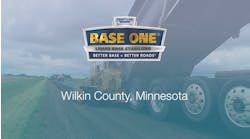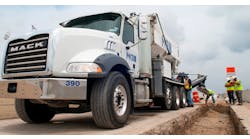By: Mary Beth Nevulis
Los Angeles has a huge network of streets––nearly 28,000 lane-miles, which, if stretched end to end, could create a highway between New York and the City of Angels with five lanes in each direction.
This makes road-recycling operations challenging for the City of Los Angeles Department of Public Works Bureau of Streets and Services (BSS). Despite the odds, BSS won a 2011 Roads & Bridges/Asphalt Recycling and Reclaiming Association Recycling Award for projects completed in 2011, which included 18 miles of roads that were resurfaced using cold in-place recycling (CIR) and 214 miles of streets resurfaced with hot-mix asphalt (HMA) for a total of 232 miles. The combined savings in using recycled materials amounted to $34 million.
A holistic plan
BSS has a strategy for the road repaving projects they approach each year.
“We take a holistic approach in terms of planning,” Keith Mozee, the division manager for the Resurfacing and Reconstruction Division of BSS, told Roads & Bridges. “We determine our goal for a month and group together resurfacing projects using a general grid of L.A. streets.”
The overall planning comprises three elements: the pavement-management system using MicroPaver, a maintenance program and a rehabilitation program.
“The pavement-management program is critical for us to determine the conditions of the streets,” said Nazario Sauceda, the director of BSS. “Through the use of MicroPaver, we can determine the right type of maintenance or rehabilitation and the right time to apply it.”
After the list of projects is compiled, and after MicroPaver makes a recommendation, an operations superintendent goes out to take stock of the locations, Mozee said. The superintendent looks at a number of factors that can affect a project: the condition of the roads; utilities in the area; traffic conditions; and residences, businesses, schools, churches and parking in the area, which the superintendent will have to contact to determine any special circumstances or events. The superintendent will also take into account the peak-hour ordinance, which dictates that roadwork cannot go on during heavy commuter traffic hours, and will then come up with a schedule and suggestions for the type of crew and equipment needed.
“Sometimes, although MicroPaver will make a recommendation that, for example, the street needs to be cold-milled, we’ll go out there and find that the street needs full reclamation as far as reconstructing the roadway,” Mozee said, which can create a challenge because the original plan will need to be modified.
Conventional cold milling operations are used for resurfacing, Sauceda said—either just cold milling the edges of the street or cold milling the full width of the street if the center of the street is too high. The type of reconstruction—whether conventional reconstruction or cold in-place recycling—is likewise determined based on the condition of the streets.
Once the superintendent inspects the project conditions, Mozee said, the type of equipment is chosen.
“We have on average 12 profiling machines, which are working profilers capable of doing all of our cold milling and rehabilitation, as well as Caterpillar [AP 1050] and Roadtec [RP 195] pavers and Hamm rollers,” Mozee said. The profilers used for these projects were Wirtgen cold in-place recyclers (the W1900, W2000 and W2100) and the rollers used were Hamm HD 110 and Hamm HD 130 HV.
The work crew will typically go in with a large profiling machine, a mini-grinder and motor sweepers, Mozee said. A follow-up crew will then do the asphalt paving and the superintendent will determine the size of the crew and how much trucking is needed so the material can be shipped in or out.
Recycling to the max
Los Angeles’ street-maintenance program includes crack sealing, slurry sealing and small asphalt or pothole repairs, Sauceda said. The city’s goals include 100 miles per year of crack sealing, 400 miles per year of slurry sealing and 250,000-300,000 pothole repairs.
“As part of our specifications, we want to make sure we maximize recycling,” Sauceda said, and that includes using both municipal asphalt plants and two plants that are contracted under vendors.
The city requires the vendor plants to provide 50% reclaimed asphalt pavement (RAP), Sauceda said, because the municipal asphalt plants are only capable of producing 600,000 tons a year of 25% RAP. The contractors pick up the difference in tonnage
“We don’t have the capability for 50% RAP because our plants are very old,” he said. “One was built in 1917 and it’s an antique. It’s operational, but not like a new asphalt plant with everything in the right place, because over the years we’ve added to it and done retrofitting.”
The city is in the process of securing funding to demolish one of the asphalt plants to convert it into a 50% RAP-producing plant, he said, but it still makes sense to have two contractors.
“Given the 480 square miles that L.A. covers, we need to have one vendor on the valley region of the city and one in the metropolitan area,” Sauceda said. “Given the traffic conditions and the size of the city, it wouldn’t be productive to have only one contractor in one part of town.”
The Westchester project
One of the projects that was part of last year’s road resurfacing was on the Via Dolce from Washington Boulevard to Marquesas Way in West Los Angeles. These roadways, which comprised 0.36 miles and 120,000 sq ft, were repaved using 1,809 tons of 50% RAP from the contracted vendor.
A challenge with this project was the area in which it was located. Mozee said that it is mainly a residential area, with many apartment buildings, so there were issues with the residents having to park their vehicles during the construction that went on.
“Sometimes people aren’t aware of the temporary tow-away signs, so we try to communicate with the apartments and pass out additional flyers whenever possible,” Mozee said.
There also were some commercial parts of the area where there was metered parking, so BSS had to be mindful of the property owners.
“We put up lane-closure signs, but kept the street open in each direction at all times, which is our primary goal,” Mozee said. “At no time would we prevent someone from going to the doctor or the grocery store.”
The Via Dolce project cost $140,625 and began with a pavement condition index (PCI) of 52—or below average—but is now back to about 100, Mozee said.
The South L.A. project
Another project was on Main Street from 99th Street to 107th Street, a concrete street in South Los Angeles. This major arterial road had a previous PCI of 64 and was a half-mile, 138,000-sq-ft project and cost $316,000.
“The PCI indicated typical concrete distress such as cracks and lifted sections or potholed sections,” Mozee said. “We don’t have a concrete-preservation program, so we came in, cold-planed the edges, cut our transitions and put a 3-in. blanket on top of the existing concrete. Now the PCI is back up to 100.”
This project cost more than double what Via Dolce did, although it was not much bigger in terms of mileage and square feet. Mozee said this was because of the street itself.
“Typically on a concrete street, 3 in. of asphalt overlay are required—we can’t just do an inch and a half,” he said. “This street was also wider, which coupled with the additional asphalt makes a significant [cost] difference.”
The Main Street project used a combination of 25% and 50% RAP: 1,502 tons from the municipal plants and 775 tons from the contracted plants for a total of 2,277 tons, said Mozee.
One challenge with this project was that this was a commercial area with many businesses to work around, Mozee said.
“This was a more highly traveled roadway than Via Dolce, so we did most of our cold milling and cold planing during the week and paved on the weekend,” he said. “Cold planing the edges of the concrete is time-consuming and will also up the cost.”
The Hollywood project
This project, which involved road resurfacing on Hollywood Boulevard from La Brea Avenue to Ogden Drive, was bigger than either Via Dolce or Main Street. A total of 4,136 tons were needed to resurface the street—3,346 of 50% RAP and 790 of 25% RAP. The area was 205,000 sq ft and .81 miles of heavily traveled arterial roadway.
“This road is used to go in and out of Hollywood from Mann’s Chinese Theater going to Highland,” Mozee said. “The roadway needed a facelift and now rideability has improved immensely.”
The PCI for this area was previously 55 and is now back up near 100, he said. The cost was $409,000.
“This project needed additional concrete work done because the gutters were basically crumbled,” Mozee said. “Another of our [BSS] divisions installed concrete bus paths ahead of us. Then the resurfacing division cut and paved the area in one to two weekends and improved the low PCI significantly.”
Because the area is so highly traveled and gets a significant amount of tourist traffic as well, traffic management was crucial to the project’s success.
“The area has a combination of tourists, commuters and residents from the Hollywood Hills, so our approach was to detour traffic around the project, but keep traffic open during certain parts of the operation,” Mozee said. “We had to be conscious of the residents because there are only certain access points for the residents coming out of the Hills.”
Sometimes they put up what is known as a soft closure, in which motorists were directed around sections of Hollywood Boulevard, using detour signs, onto other streets before returning to the Boulevard.
“People who know the area will drive around the project, but because of the tourists, we will not just close the roadway and make them figure it out on their own,” Mozee said.
Looking forward
This year, the Resurfacing and Reconstruction Division will try to merge the resurfacing and slurry database into one comprehensive pavement-preservation program, Mozee said. If elected officials accept this merge, it is hoped that the single-entity program will lead to equalization and improvement of the PCI of the entire 6,500-street network.
“With infrastructure programs, there isn’t enough money to do everything all at once,” Mozee said. “We need to look for more creative ways to tighten our belt.” R&B


